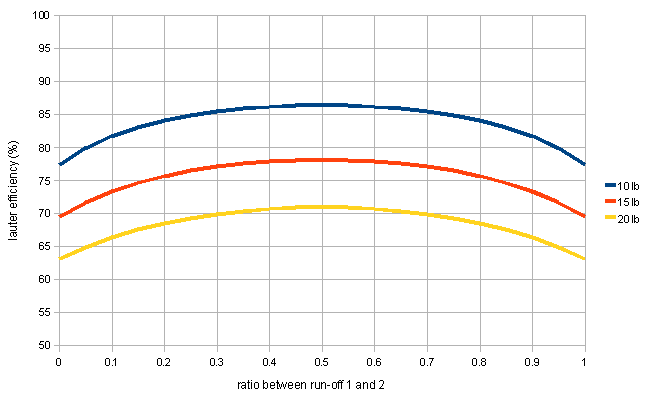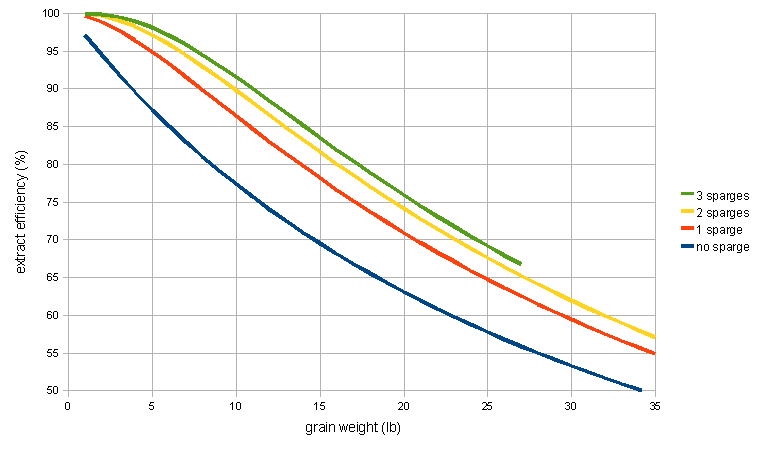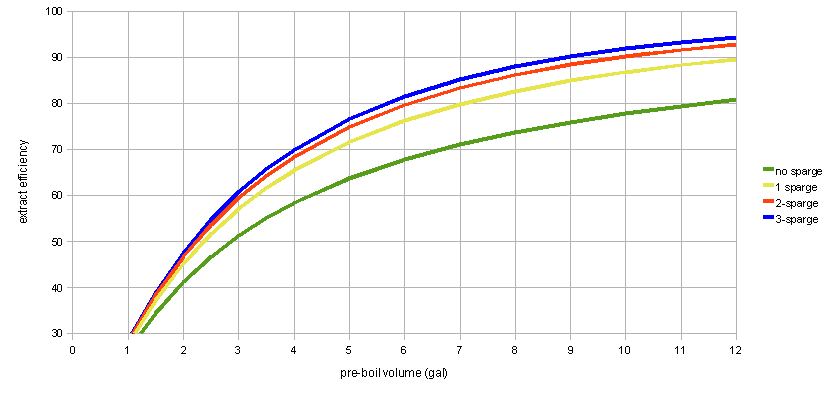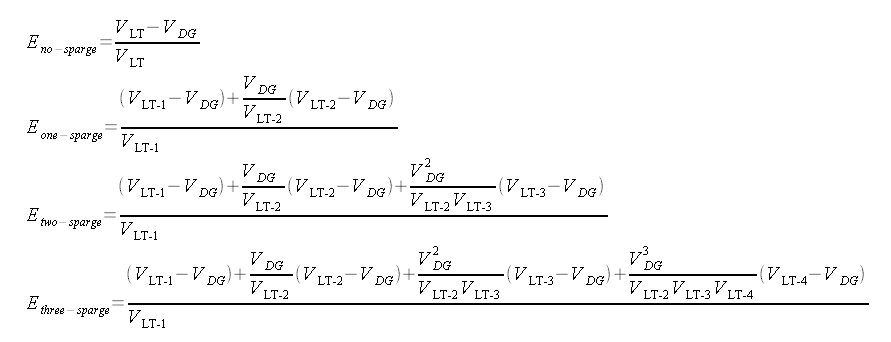Difference between revisions of "Batch Sparging Analysis"
(→Effect of the grist size (weight)) |
|||
| Line 31: | Line 31: | ||
<div style="clear:both;"></div> | <div style="clear:both;"></div> | ||
| − | [[Image:Batch_sparging_run_off_ratio.gif|frame|left|Lauter efficiency as a function of the relative size between the first run-off volume and the total pre-boil volume in a 1 sparge batch sparging scenario. (A = 0.19 gal/lb, V<sub>D</sub>=0 gal)]] | + | [[Image:Batch_sparging_run_off_ratio.gif|frame|left|Lauter efficiency as a function of the relative size between the first run-off volume and the total pre-boil volume in a 1 sparge batch sparging scenario. (V<sub>b</sub>=6.5 gal, A = 0.19 gal/lb, V<sub>D</sub>=0 gal)]] |
<div style="clear:both;"></div> | <div style="clear:both;"></div> | ||
Revision as of 17:04, 30 November 2009
Because of its simplicity and its static nature batch sparging lends itself to being easily modeled mathematically. Though some of the work has already been done before and publicized (for example Ken Schwartz's evaluation), this article focuses on illustrating the trends and conclusions that can be drawn from the mathematical analysis of batch sparging rather than the derivation of the formulas themselves. For the interested reader, the final section provides information on how the formulas were derived.
Note that this article only discusses the lauter efficiency for batch sparging. As discussed in Understanding Efficiency the efficiency into the kettle (or brewhouse efficiency) is the product of conversion and lauter efficiency:
brewhouse efficiency = conversion efficiency * lauter efficiency
Contents
Assumptions
In order to model batch sparging, two fundamental assumptions must be made:
- The mash is completed at the start of the lauter and no additional starches are converted during the lauter. The closer the conversion efficiency during mashing came to 100% the less starch conversion can happen during lautering
- after the mash has been drained, all the converted extract that remains in the mash tun is contained in water that is held back by the grain and/or the dead space of the mash tun
- adding another batch of sparge water will only dilute the wort left in in mash tun and not extract additional extract from the grains
Model and Formulas Used
The mathematical model for batch sparging assumes that all the extract is dissolved in the water volume in the lauter tun (VLT) and that this liquid is drained until only the dead space and volume absorbed by the grain remains in the lauter tun (VDG). More water is then added to the lauter tun which will evenly dilute the amount of wort that remained after the first run-off. The lauter is then drained again and added to the run-offs already in the boil kettle.
These are the parameters that will be important when modeling batch sparging
- VLT-n - wort volume in the mash tun before run-off step n (in gal)
- VD - dead volume of the lauter tun. This is the volume of water that cannot be drained from the lauter tun even if it doesn't contain any grain (in gal)
- mG - the weight of the grist (in lb)
- A - the grain absorption ratio for wort (in gal/lb)
- VDG - the amount of wort left in the lauter tun after draining it equals the dead space plus the wort absorbed by the grain: VDG = VD + A * mG
- Vr-n - run-off volume for each run-off. It is the difference between the volume in the lauter tun and the volume kept in the lauter tun: Vr-n = VLT-n - VDG
- Vb - the preboil volume of wort collected. It is the sum of the run-off volumes: Vb = Vr-1 + Vr-2 ...
Effect of the relative run-off sizes
The first parameter that should be examined is the effect of the relative run-off sizes. Obviously this only applies to batch sparging with 1 or more sparges as there is only one run-off in no-batch sparging. To make this experiment, batch sparging with 2 run-offs is used and the parameter that is varied is the ratio between the first run-off volume (Vr-1) and the pre-boil volume (Vb). In the Eone-sparge formula this will affect VLT-1 and VLT-2. The experiment is repeated for 3 grist weights (10 lb, 15 lb and 20 lb).
An efficiency optimum exists when the 1st and 2nd run-off are both half the pre-boil volume, but it is also apparent that even slightly uneven run-offs are very close to the optimum. Towards the edges, where one of the run-offs comes close to or is the total boil volume, the efficiency drops by almost 10%. This is the efficiency difference between a no-sparge and a single batch sparge.
The efficiency curve is shifted towards lower efficiency as the amount of grain increases (note that the pre boil volume is held constant and that all the curves are for single batch sparging). This comes from the increased amount of wort that is left behind in the greater amount of grain and will be examined in more detail in the next section.
Conclusions:
- in batch sparging the run-offs should be of equal size to achieve maximum lauter efficiency
- But, eyeballing the volumes is just fine since slight or moderate inequalities will not lead to a significant drop in efficiency
Though it was only shown for the one-sparge case that the run-offs should be of equal size, further experiments will assume that all run-offs are of equal size even for the 2 and 3 sparge cases.
Effect of the grist size (weight)
The size of the grist and/or its absorption ratio have a significant effect on the batch sparging lauter efficiency. The more wort is held back by the grain and the lauter tun's dead space, the more extract will remain in the grains after running of. Subsequent sparging batches can not deliver all the extract into the boil kettle, they can only capture a part of the extract that was left behind. But as the number of sparges is increased the increase in efficiency is diminishing. Keep in mind that in all these cases the pre-boil volume is kept the same. As a result, the run-off amount for each sparge gets smaller as the number of sparges is increased.
The following graph illustrates the effect of the grain weight and number of run-offs (1, 2, 3 and 4) on the lauter efficiency. The lines stop when the water to grain ratio is less than 1 qt/lb which makes for an unrealistic sparging scenario.
The range interesting for most brewers is between 8 and 20lb of grain (assuming 5gal batches).
True v.s apparent grain absorption
At this point it is important to discuss how grain absorption is calculated and the difference between what I call true and apparent grain absorption.
Most commonly grain absorption is calculated by taking the difference between the total volume of water that has been used for mashing and sparging and subtracting the volume of wort that has been collected in the kettle. If the grain bed was not run “dry” after the sparge any additional wort that can still be drained from the grain also needs to be subtracted from the total water volume. In the absence of any large dead spaces (e.g. under the false bottom) the calculated volume difference is assumed to be held back in the grain and when we divide it by the original grist weight we get the apparent grain absorption. For most brewers this number is around 1 l/kg or 0.12 gal/lb. This is also the number that brewing software uses to determine the amount of water that is needed to produce a targeted volume of pre-boil wort.
But this calculation is neglecting that the volume of a sugar solution is greater than the volume of just its water component. You can try this at home: mark the water line in a glass of water and add sugar. Even after the sugar is dissolved the volume of the sugar solution is larger than the initial water volume. The volume increase per sugar, or extract, amount can be calculated by using the fact that Plato is an expression of weight percent sugar, that the specific gravity can be determined from Plato through tables or equations and that specific gravity is nothing more than the weight of a known volume. If this is done one finds that each kg of sugar or extract extracted in the mash increases the volume of the wort by about 0.63 l (0.63 l/kg or 0.3 qt/lb). Since the relation between Plato and specific gravity is not exactly linear the volume increase per weight of extract is not linear either but close enough for our purposes. This increases the total volume of liquid that is produced during brewing and it needs to be accounted for when we want to know the actual volume that is held back in the grain after a run-off. In case the conversion in the mash is complete (i.e. 100% of the starches have been converted and dissolved) typical true grain absorption is around 1.56 l/kg or 0.19 gal/lb. That number is assumed for modeling batch sparging in this article.
When brewers talk about grain absorption numbers they generally mean the apparent grain absorption. This is just like the apparent v.s real attenuation difference where we brewers imply that we mean apparent attenuation if we talk about attenuation but know that there is a real attenuation as well.
Conclusion:
- the more grain used, the more the efficiency will suffer. This can be counteracted by more sparging batches, but there is a limit to the efficiency that can be achieved with a given grist size, absorption ratio and pre-boil volume
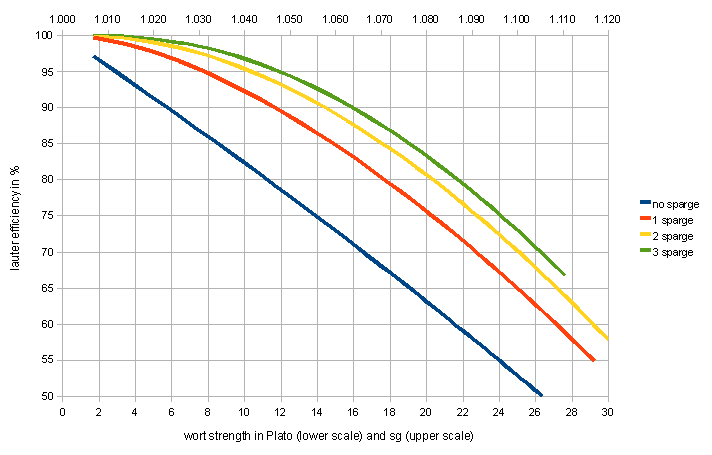
Effect of the pre-boil volume
The diagram below shows it: the larger the pre-boil volume, the higher the efficiency will be. This is obvious since more sparge water is available to get more of the extract in the boil kettle. But here is the catch, brewers don't aim max for efficiency, they aim for a target extract percentage (gravity) and cast out wort volume. The targeted cast-out wort volume, boil-off rate and boil time require a certain pre-boil volume and as a result of that here is only limited flexibility for increasing the pre-boil volume to increase the efficiency:
Assuming a cast out volume target of 5.5 gal, the pre-boil volume could be as large as 7.3 gal. This assumes a boil-off rate of 15%/hr and a boil time of 2 hrs. Neither the boil-of rate nor the boil time should be increased as this can be detrimental to the beer. A higher boil-off rate can "burn" the wort through the increased thermal loading and a longer boil would coagulate too many of the proteins in the wort which hurts head retention and body.
Changing the pre-boil volume from 6.5 (15 %/hr and 1 hr boil) to 7.5 gal (15 %/hr and 2 hr boil) only gains about 3% efficiency for the shown example (mG=15 lb, A = 0.13 gal/lb, VD=0 gal)
Conclusion:
- though the pre-boil volume has an effect on the efficiency it is set in fairly tight bounds and in these bounds the efficiency won't change much
Last running gravity
In fly sparging there is a concern of over-sparging the grain which can lead to excessive tannin extraction from the grain husks. The same concern may exist for batch sparging, that's why the extract content for no-sparge and the run-off for 2, 3 and 4 run-off batch sparges were analyzed. Though pH is more important for tannin extraction than run-off gravity, the gravity can be used as a measure that indicates how much the pH of the wort is still buffered.
The diagram below shows the results for a constant pre-boil volume (6.5 gal) while varying the size of the grain-bill. The thin lines show the gravity of the run-offs for the 2, 3 and 4 run-off batch sparges except for the last run-offs. These are shown with thick lines. Interestingly enough, the last run-offs for 2, 3 and 4 run-off sparges follow approximately the same curve. This means no matter how many times you sparge (assuming equal run-off sizes), the gravity of the last run-off is determined by the volume that remains in the MLT after each run-off (grain weight * absorption ratio) and the pre-boil volume. Both these parameters are fairly fixed for a particular recipe. The only exception is the run-off gravity for no-sparge which is much higher.
I suspect that there are 2 effects at work that compensate each other to some degree since the graphs for the last running gravity of a 1 or more sparge lauter are not identical. They are just very close to each other. The more run-offs are made, the smaller the liquid amount in the lauter tun has to be to ensure equal run-off sizes. As an effect of that the extract level (gravity) of the 1st running will be increasingly higher as more sparge steps are added. As an example, a 1 sparge lauter may start with a 15 Plato 1st running wort and end with a 2 Plato last running wort, while a 2 sparge lauter of the same mash has to start with a 19 Plato first wort. At the end, the 2 sparge lauter will also end with a 2 Plato wort, but since it started at 19 Plato, compared to 15 Plato, its dilution rate is higher which is what you would expect from additional sparges.
Conclusion:
- the number of run-offs will not have a significant in the gravity of the last run-off and therefore the tannin extract potential.
Summary
While being more predictable and easier to conduct than fly-sparging, the nature of batch sparging (repeated dillution of wort left in the lauter tun) provides an inherent limit to the brew-house efficiency. This efficiency is determined by pre-boil volume, grain weight, wort absorption ratio of the grain, lauter tun dead space, relative size of the run-offs and number of sparges. Many of these parameters are set by the recipe (grain weight) or process parameters (absorption ratio and lauter tun dead space) that cannot be changed while others can be changed in limited bounds (pre-boil volume). The number of sparges is one parameter that can easily be changed, but there is only a diminishing return to making a 4th or even 5th run-off which does not compensate for the increased effort. Many sparges while trying to keep the pre-boil volume constant will also lead to thicker mashes which make it difficult to evenly mix in the sparge water which was an assumption made for this analysis. If the water is not evenly mixed, less extract may be run-off and the efficiency may suffer.
At this point the theoretical batch sparging lauter efficiency can be used to determine how well a brewers batch sparging process stacks up against the theory and how the efficiency is expected to change when a brewer decides to brew a larger beer or wants to change to no-sparge. If the actual efficiency is way lower than the theoretically expected one, a brewer may want to troubleshoot why the efficiency is unexpectedly low. Mot likely it is the result of lower conversion efficiency which means that a significant amount of starch was not converted during the mash.
These articles cover efficiency in more detail:
Example: How well am I doing with my batch sparging
--- out of date as the calculation doesn't account for the volume added by the extracted sugars ---
Here is an example that shows how the efficiency from an actual brew day is compared to the theoretical efficiency:
- total water used (cold) VT = 8.0 gal
- pre-boil volume (hot) Vb-hot = 6.6 gal
- grain weight mG = 8.9 lb
- extract efficiency calculated from the malts laboratory extract Eactual = 85 %
First, the hot pre-boil volume measurement needs to be corrected to a cold volume. Boiling hot Water shrinks by about 4% when cooled to room temperature:
Vb = Vb-hot * (1 - 0.04) = 6.6 gal * 0.96 = 6.3 gal
The volume of water left in the MLT (grain absorption + dead volume) is the amount of water used minus the temperature corrected pre-boil. This does not take into account that the volume of wort is slightly larger than the volume of the water contained in that volume of wort. But since this difference is not significant for these calculations, especially for lower gravity beers, it is not accounted for.
VDG = VT - Vb = 8.0 - 6.3 = 1.7 gal
If all of that volume can be attributed to grain absorption, then the absorption factor A is
A = VDG / mG = 1.7 gal / 8.9 lb = 0.19 gal/lb
When equal run-off sizes were chosen, the size of each run-off is
VR = Vb / 2 = 3.15 gal
and the lauter tun volume before each run-off is
VLT = VR + VDG = 3.15 gal + 1.7 gal = 4.85
For a single batch sparge, the theoretical efficiency is
Etheory = (VR + (VDG * VR) / VLT) / VLT = ((3.15 + (1.7 * 3.15) / 4.85) / 4.85 = 88%
The actual efficiency, which was 85%, is 96% of the maximum efficiency. This is pretty good and indicates that there will be little that the brewer can do to improve the crush or mash conversion. Based on that relationship, which expresses how much of the extract potential actually made it into the wort, one can calculate the expected efficiencies for no-sparge and 2-sparge batch sparging:
Etheory-no-sparge = Vb / VT = 6.3 / 8.0 = 79 %
96% of that are 76% expected no-sparge efficiency. In reality the efficiency will be a little worse since the amount of grain has to be increased which increases the amount of water needed to get to the same pre-boil volume.
For 2-sparge batch sparging the theoretical efficiency is
Etheory-2-sparge = VR-2-sparge (1 + VDG / VLT-2-sparge + (VDG / VLT-2-sparge)2) / VLT-2-sparge = 2.1 ( 1 + 1.7 / 3.8 + (1.7 / 3.8)2) / 3.8 = 91 %
96% of that are 87% and the actual efficiency will be slightly better since less grain is necessary which reduces VDG which increases the efficiency. But this increase is not significant enough to require consideration.
In the end the brewer will have to decide if a 2% increase is worth the hassle of an additional sparge.
Formulas
The efficiency in this case is defined as the amount of extract that made it into the boil kettle vs the maximum amount of extract that can be obtained from the grains. The latter is determined through laboratory analysis of the grain. If we assume a perfect mash and that all the grains extract is dissolved into the mash water (resulting in an extract content of e) we can write the efficiency as:
E = (e * Vb) / (e * VLT)
Since the actual extract content e is redundant and with the pre-boil for a no-sparge lauter being VLT - VDG, the efficiency for no-sparge is:
E = (VLT - VDG) / VLT
to be completed
As you can see with each sparge a new term is added to the efficiency, but it's contribution to the total efficiency will be smaller and smaller as the number of run-offs is increased. The following sections will vary various parameters in these formulas to give the brewer an idea how they will effect the efficiency.
